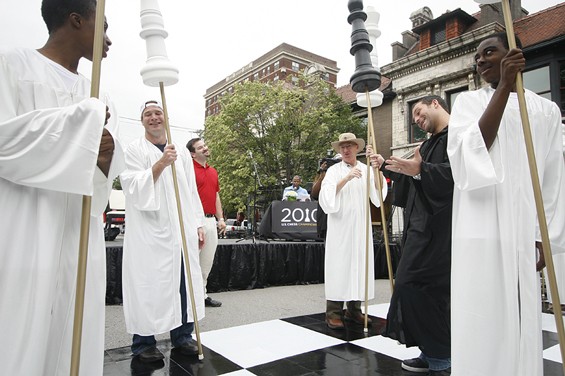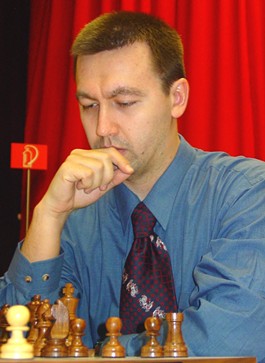Twenty-four players from across the country competed in the U.S Championship, which took place at the Chess Club and Scholastic Center of St. Louis.
The opening rounds of the tournament were played in a commonly used format called the "Swiss-system." The top four players from this stage (Hikaru Nakamura, Gata Kamsky, Yury Shulman, and Alex Onischuk -- the top four seeds) advanced to a round-robin against each other.
Shulman and Kamsky played each other to a draw in the championship match. That led to Armageddon.
No seriously, "Armageddon" is the what the overtime system is called.
In this format, the player using the black pieces only has to end the game in a draw to win, while the player using the white pieces has to earn an outright victory. To decide who gets which side, the players "bid" time off their sixty-minute game clock.
"If one of the players wants a draw they can play more conservatively," explains John Strand, the assistant director of the Chess Club. "It's a big deal, it makes you the heavy favorite even with black."
Without knowing how much time their opponent was willing to sacrifice, Shulman bid 21 minutes off the clock and Kamsky offered 35 minutes.
That left Kamsky with just 25 minutes to complete every move in the game as black versus the sixty minutes that Schulman had to complete his moves with the white pieces.
Sixty-six moves later (see the whole sequence here), the game ended in another draw. Meaning that Kamsky was crowned champion.
Confused? You're not alone.
The comments thread on the Chess Club and Scholastic Center's website is full of pissed off chess fans who felt the system was both unfair and unsatisfying.
"I prefer co-champions rather than a decision based on a garbage game more suitable to hustlers in a park," one comment said, echoing the sentiments of others.
Strand says it was the first time the Armageddon system had been used to decide a championship.
"I don't know exactly what motivated that," Strand says. "I speculate that it was a long tournament already and we wanted something that would generate a clear winner in a brief amount of time."
"Typically you have them playoff in a series of rapid games but because you need to have both black and white an equal number of times it may still be a draw," he added. "This way, the Armageddon, the determination of color is based on bidding. You can't say that it favors one person or the other."
As for the co-champion suggestion or other alternatives, Strand said, "Having co-champions is kind of inherently unsatisfying. A lot more people would be unhappy without a clear winner. Any format has drawbacks that people consider flawed."
The Chess Club and Scholastic Center has a video replay the whole match streaming on their website, complete with color commentary and analysis from other chess players. It's just like the Super Bowl, minus the concussions and Bud Light commercials.
Related Content:
Human Chess Game (gallery)

Photo: Nick Schnelle
See more photos of this game right here: Human Chess Game at the Chess Club






